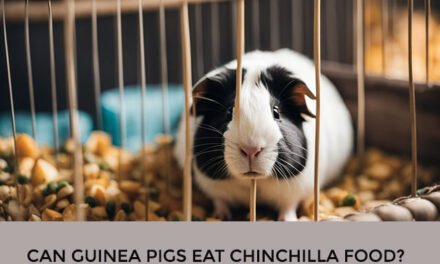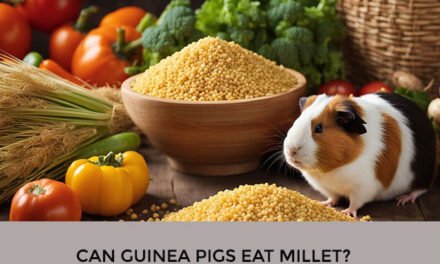Guinea pigs are adorable little creatures that make great pets. They are herbivores and require a balanced diet that includes fresh fruits, vegetables, and hay. Wheatgrass has become increasingly popular as a health food for humans, but can guinea pigs eat wheatgrass too? In this article, we will explore whether wheatgrass is safe and beneficial for guinea pigs to consume.
Wheatgrass is a type of grass that is packed with nutrients and is often consumed as a dietary supplement by humans. It is known for its high levels of vitamins A, C, and E, as well as antioxidants and chlorophyll. However, just because something is healthy for humans does not necessarily mean it is safe for guinea pigs. We will examine the nutritional content of wheatgrass and whether it is suitable for guinea pigs to eat.
Nutritional Benefits of Wheat Grass for Guinea Pigs

Wheat grass is a nutrient-rich plant that can provide several benefits to guinea pigs when consumed in moderation. Here are some of the nutritional benefits of wheat grass for guinea pigs:
- High in fiber: Wheat grass is an excellent source of fiber, which is essential for maintaining healthy digestion in guinea pigs.
- Rich in vitamins and minerals: Wheat grass contains several vitamins and minerals, including vitamin A, vitamin C, vitamin E, iron, and calcium, which are all vital for the overall health and well-being of guinea pigs.
- Antioxidant properties: Wheat grass is known to have antioxidant properties that can help boost the immune system of guinea pigs and protect them from various diseases and infections.
- Helps with weight management: Wheat grass is low in calories and can help guinea pigs maintain a healthy weight when incorporated into their diet.
- Promotes dental health: The fibrous nature of wheat grass can help wear down the teeth of guinea pigs, preventing dental problems such as overgrown teeth.
It is important to note that while wheat grass can provide several nutritional benefits to guinea pigs, it should only be given to them in moderation as too much of it can cause digestive problems. It is always best to consult with a veterinarian before introducing any new food to your guinea pig’s diet.
Safe Feeding Practices

When feeding wheatgrass to guinea pigs, it is important to follow safe feeding practices to ensure their health and well-being. Here are some tips to keep in mind:
- Introduce wheatgrass gradually: Guinea pigs have sensitive digestive systems, so it is important to introduce new foods gradually. Start by offering a small amount of wheatgrass and monitor your guinea pig’s reaction. If they show signs of digestive upset, such as diarrhea or vomiting, stop feeding wheatgrass and consult with a veterinarian.
- Wash wheatgrass thoroughly: Wheatgrass can harbor bacteria and other harmful substances, so it is important to wash it thoroughly before feeding it to your guinea pig. Rinse it under running water and pat it dry with a clean towel.
- Offer wheatgrass as a supplement, not a replacement: While wheatgrass is a nutritious food, it should not be the sole source of your guinea pig’s diet. Make sure to offer a variety of fresh vegetables, hay, and pellets to ensure a balanced diet.
- Avoid pesticides and fertilizers: When growing wheatgrass for your guinea pig, make sure to use organic seeds and avoid using pesticides and fertilizers. These chemicals can be harmful to your guinea pig’s health.
By following these safe feeding practices, you can ensure that your guinea pig stays healthy and happy when eating wheatgrass.
Potential Risks and Considerations

When considering feeding wheatgrass to guinea pigs, there are a few potential risks and considerations to keep in mind.
First, it is important to note that while wheatgrass is generally safe for guinea pigs to eat, some guinea pigs may have a sensitivity or allergy to it. As with any new food, it is important to introduce wheatgrass slowly and in small quantities to monitor any adverse reactions.
Additionally, while wheatgrass is a nutritious food, it is important to ensure that it does not make up the majority of a guinea pig’s diet. Guinea pigs require a balanced diet of hay, fresh vegetables, and a small amount of pellets. Overfeeding wheatgrass or any other single food can lead to nutritional imbalances and health issues.
Finally, it is important to consider the source of the wheatgrass. If the wheatgrass is grown in soil that has been treated with pesticides or other chemicals, it may not be safe for guinea pigs to consume. It is best to source wheatgrass from a trusted supplier or to grow it yourself using organic methods.
Overall, while wheatgrass can be a nutritious addition to a guinea pig’s diet, it is important to introduce it slowly and in moderation, and to ensure that it is sourced from a safe and reliable source.
How to Introduce Wheat Grass to Your Guinea Pig
Introducing new foods to your guinea pig’s diet can be a bit tricky, but with the right approach, you can make it a smooth transition. Wheat grass is a great addition to your guinea pig’s diet, as it is packed with essential nutrients and vitamins. Here’s how to introduce wheat grass to your guinea pig:
Preparing Wheat Grass
Before giving wheat grass to your guinea pig, it’s important to prepare it properly. Start by washing the wheat grass thoroughly to remove any dirt or debris. Then, chop the wheat grass into small pieces to make it easier for your guinea pig to eat. You can also mix it with other vegetables to create a tasty salad for your furry friend.
Portion Control and Frequency
When introducing a new food to your guinea pig, it’s important to start with small portions and gradually increase the amount over time. For wheat grass, start by giving your guinea pig a small piece and monitor their reaction. If they seem to enjoy it and have no adverse reactions, you can gradually increase the amount.
It’s also important to consider the frequency of feeding wheat grass to your guinea pig. While it’s a nutritious food, it should not be the main staple of their diet. Instead, it should be given as a treat or supplement to their regular diet.
In conclusion, introducing wheat grass to your guinea pig can be a great way to provide them with essential nutrients and vitamins. By following these simple steps, you can ensure a smooth transition and keep your furry friend healthy and happy.
Alternatives to Wheat Grass
If you are looking for alternatives to wheat grass for your guinea pig, there are several options available. Here are some of the most popular ones:
1. Timothy Hay
Timothy hay is an excellent source of fiber and can be given to guinea pigs in unlimited amounts. It is also low in calcium, which makes it ideal for guinea pigs prone to bladder stones. Timothy hay is readily available at pet stores and online.
2. Oat Grass
Oat grass is another type of grass that is safe for guinea pigs to eat. It is high in fiber and nutrients, making it a great addition to your guinea pig’s diet. Oat grass can be grown at home using seeds or purchased online.
3. Romaine Lettuce
Romaine lettuce is a great source of vitamin C and other nutrients that guinea pigs need. It is also low in calcium, which makes it a good choice for guinea pigs prone to bladder stones. However, it should be given in moderation as it is also high in water content.
4. Kale
Kale is another leafy green that is safe for guinea pigs to eat. It is high in vitamin C and other nutrients that guinea pigs need. However, it should be given in moderation as it is also high in calcium.
Overall, there are several alternatives to wheat grass that are safe and nutritious for guinea pigs. It is important to provide a variety of foods to ensure that your guinea pig gets all the nutrients it needs.
Understanding Guinea Pigs’ Dietary Needs

As responsible pet owners, it is important to understand the dietary needs of our guinea pigs. Guinea pigs are herbivores, which means that their diet should consist of fresh fruits and vegetables, hay, and pellets.
Guinea pigs require a diet that is high in fiber, as their digestive system is designed to process a lot of plant material. This is why hay is an essential part of their diet, as it provides the necessary fiber that helps keep their digestive system healthy.
It is also important to provide guinea pigs with a variety of fresh fruits and vegetables, as this helps ensure that they receive all the necessary vitamins and minerals that they need. However, it is important to note that not all fruits and vegetables are safe for guinea pigs to eat. For example, guinea pigs should not be fed avocado, as it is toxic to them.
When introducing new foods to your guinea pig’s diet, it is important to do so gradually. This allows their digestive system to adjust to the new food and helps prevent any digestive issues.
In conclusion, understanding the dietary needs of our guinea pigs is crucial for their overall health and wellbeing. By providing them with a diet that is high in fiber and includes a variety of fresh fruits and vegetables, we can ensure that they are happy and healthy.
Frequently Asked Questions
What types of grass are safe for guinea pigs to consume?
Guinea pigs can safely consume a variety of grasses, including wheat grass, timothy grass, orchard grass, and meadow grass. However, it is important to ensure that the grass is fresh, free of pesticides, and not treated with any chemicals.
Are there any health benefits to feeding guinea pigs wheat grass?
Yes, wheat grass is a great source of vitamins and minerals, including vitamin C, which is essential to a guinea pig’s diet. It also contains antioxidants and can aid in digestion.
How often can guinea pigs have wheat grass in their diet?
Wheat grass should be fed to guinea pigs in moderation, as it is high in fiber and can cause digestive issues if consumed in large quantities. We recommend offering wheat grass as a treat, no more than once or twice a week.
What is the best way to introduce wheat grass into a guinea pig’s diet?
When introducing wheat grass into a guinea pig’s diet, it is important to start with small amounts and gradually increase the quantity over time. This will allow their digestive system to adjust to the new food. We also recommend offering wheat grass in addition to their regular diet of hay, pellets, and fresh vegetables.
Can wheat grass replace hay in a guinea pig’s daily nutrition?
No, hay is an essential part of a guinea pig’s diet and should not be replaced with wheat grass. Hay provides the necessary fiber for proper digestion and helps maintain healthy teeth.
Are there any risks associated with feeding guinea pigs wheat grass?
While wheat grass is generally safe for guinea pigs to consume, it is important to ensure that it is fresh and free of pesticides. Additionally, if a guinea pig has a history of digestive issues, it may be best to avoid feeding them wheat grass. As always, consult with a veterinarian before making any changes to your guinea pig’s diet.





